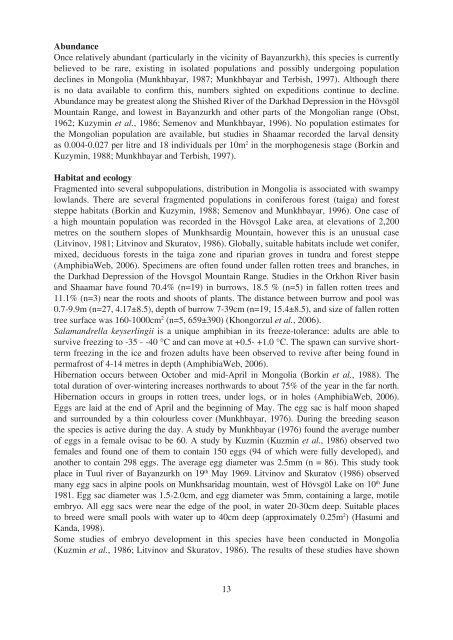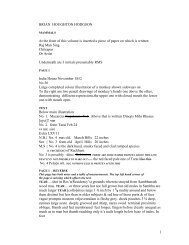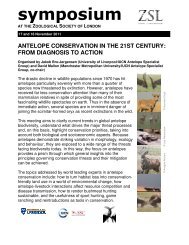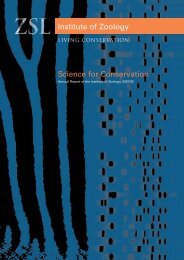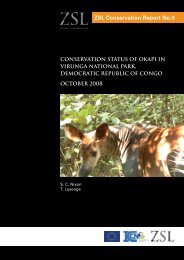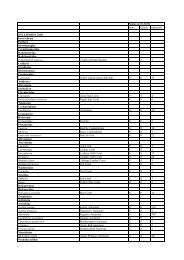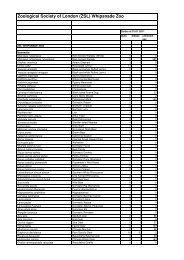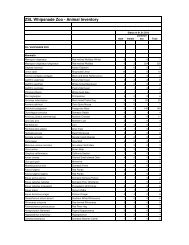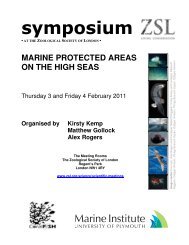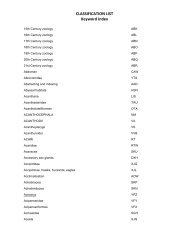Summary Conservation Action Plans for Mongolian Reptiles and ...
Summary Conservation Action Plans for Mongolian Reptiles and ...
Summary Conservation Action Plans for Mongolian Reptiles and ...
Create successful ePaper yourself
Turn your PDF publications into a flip-book with our unique Google optimized e-Paper software.
Abundance<br />
Once relatively abundant (particularly in the vicinity of Bayanzurkh), this species is currently<br />
believed to be rare, existing in isolated populations <strong>and</strong> possibly undergoing population<br />
declines in Mongolia (Munkhbayar, 1987; Munkhbayar <strong>and</strong> Terbish, 1997). Although there<br />
is no data available to confi rm this, numbers sighted on expeditions continue to decline.<br />
Abundance may be greatest along the Shished River of the Darkhad Depression in the Hövsgöl<br />
Mountain Range, <strong>and</strong> lowest in Bayanzurkh <strong>and</strong> other parts of the <strong>Mongolian</strong> range (Obst,<br />
1962; Kuzymin et al., 1986; Semenov <strong>and</strong> Munkhbayar, 1996). No population estimates <strong>for</strong><br />
the <strong>Mongolian</strong> population are available, but studies in Shaamar recorded the larval density<br />
as 0.004-0.027 per litre <strong>and</strong> 18 individuals per 10m 2 in the morphogenesis stage (Borkin <strong>and</strong><br />
Kuzymin, 1988; Munkhbayar <strong>and</strong> Terbish, 1997).<br />
Habitat <strong>and</strong> ecology<br />
Fragmented into several subpopulations, distribution in Mongolia is associated with swampy<br />
lowl<strong>and</strong>s. There are several fragmented populations in coniferous <strong>for</strong>est (taiga) <strong>and</strong> <strong>for</strong>est<br />
steppe habitats (Borkin <strong>and</strong> Kuzymin, 1988; Semenov <strong>and</strong> Munkhbayar, 1996). One case of<br />
a high mountain population was recorded in the Hövsgol Lake area, at elevations of 2,200<br />
metres on the southern slopes of Munkhsardig Mountain, however this is an unusual case<br />
(Litvinov, 1981; Litvinov <strong>and</strong> Skuratov, 1986). Globally, suitable habitats include wet conifer,<br />
mixed, deciduous <strong>for</strong>ests in the taiga zone <strong>and</strong> riparian groves in tundra <strong>and</strong> <strong>for</strong>est steppe<br />
(AmphibiaWeb, 2006). Specimens are often found under fallen rotten trees <strong>and</strong> branches, in<br />
the Darkhad Depression of the Hovsgol Mountain Range. Studies in the Orkhon River basin<br />
<strong>and</strong> Shaamar have found 70.4% (n=19) in burrows, 18.5 % (n=5) in fallen rotten trees <strong>and</strong><br />
11.1% (n=3) near the roots <strong>and</strong> shoots of plants. The distance between burrow <strong>and</strong> pool was<br />
0.7-9.9m (n=27, 4.17±8.5), depth of burrow 7-39cm (n=19, 15.4±8.5), <strong>and</strong> size of fallen rotten<br />
tree surface was 160-1000cm 2 (n=5, 659±390) (Khongorzul et al., 2006).<br />
Salam<strong>and</strong>rella keyserlingii is a unique amphibian in its freeze-tolerance: adults are able to<br />
survive freezing to -35 - -40 °C <strong>and</strong> can move at +0.5- +1.0 °C. The spawn can survive shortterm<br />
freezing in the ice <strong>and</strong> frozen adults have been observed to revive after being found in<br />
permafrost of 4-14 metres in depth (AmphibiaWeb, 2006).<br />
Hibernation occurs between October <strong>and</strong> mid-April in Mongolia (Borkin et al., 1988). The<br />
total duration of over-wintering increases northwards to about 75% of the year in the far north.<br />
Hibernation occurs in groups in rotten trees, under logs, or in holes (AmphibiaWeb, 2006).<br />
Eggs are laid at the end of April <strong>and</strong> the beginning of May. The egg sac is half moon shaped<br />
<strong>and</strong> surrounded by a thin colourless cover (Munkhbayar, 1976). During the breeding season<br />
the species is active during the day. A study by Munkhbayar (1976) found the average number<br />
of eggs in a female ovisac to be 60. A study by Kuzmin (Kuzmin et al., 1986) observed two<br />
females <strong>and</strong> found one of them to contain 150 eggs (94 of which were fully developed), <strong>and</strong><br />
another to contain 298 eggs. The average egg diameter was 2.5mm (n = 86). This study took<br />
place in Tuul river of Bayanzurkh on 19 th May 1969. Litvinov <strong>and</strong> Skuratov (1986) observed<br />
many egg sacs in alpine pools on Munkhsaridag mountain, west of Hövsgöl Lake on 10 th June<br />
1981. Egg sac diameter was 1.5-2.0cm, <strong>and</strong> egg diameter was 5mm, containing a large, motile<br />
embryo. All egg sacs were near the edge of the pool, in water 20-30cm deep. Suitable places<br />
to breed were small pools with water up to 40cm deep (approximately 0.25m 2 ) (Hasumi <strong>and</strong><br />
K<strong>and</strong>a, 1998).<br />
Some studies of embryo development in this species have been conducted in Mongolia<br />
(Kuzmin et al., 1986; Litvinov <strong>and</strong> Skuratov, 1986). The results of these studies have shown<br />
13


